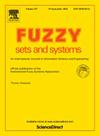The general algebraic solution of dual fuzzy linear systems and fuzzy Stein matrix equations
IF 3.2
1区 数学
Q2 COMPUTER SCIENCE, THEORY & METHODS
引用次数: 0
Abstract
In this paper, we present a new method for solving a dual fuzzy linear system (DFLS), , where the coefficient matrices A and B are arbitrary real matrices and and are given fuzzy number vectors. A necessary and sufficient condition for the -consistency of the associated system of linear equations is obtained. The straightforward method for solving DFLS based on an arbitrary {1}-inverse of is introduced. Also, as an application, we present the first algorithm for solving the fuzzy Stein matrix equations, based on {1}-inverses. Finally, these results are illustrated by examples.
对偶模糊线性系统和模糊斯坦因矩阵方程的一般代数解法
本文提出了一种求解对偶模糊线性方程组(DFLS)AX˜+C˜=BX˜+D˜ 的新方法,其中系数矩阵 A 和 B 是任意实 m×n 矩阵,C˜ 和 D˜ 是给定的模糊数向量。得出了相关线性方程组 R 一致性的必要条件和充分条件。介绍了基于 A-B 的任意 {1} 逆的 m×n DFLS 直接求解方法。此外,作为一种应用,我们提出了第一种基于{1}逆的模糊斯坦因矩阵方程求解算法。最后,我们通过实例对这些结果进行了说明。
本文章由计算机程序翻译,如有差异,请以英文原文为准。
求助全文
约1分钟内获得全文
求助全文
来源期刊

Fuzzy Sets and Systems
数学-计算机:理论方法
CiteScore
6.50
自引率
17.90%
发文量
321
审稿时长
6.1 months
期刊介绍:
Since its launching in 1978, the journal Fuzzy Sets and Systems has been devoted to the international advancement of the theory and application of fuzzy sets and systems. The theory of fuzzy sets now encompasses a well organized corpus of basic notions including (and not restricted to) aggregation operations, a generalized theory of relations, specific measures of information content, a calculus of fuzzy numbers. Fuzzy sets are also the cornerstone of a non-additive uncertainty theory, namely possibility theory, and of a versatile tool for both linguistic and numerical modeling: fuzzy rule-based systems. Numerous works now combine fuzzy concepts with other scientific disciplines as well as modern technologies.
In mathematics fuzzy sets have triggered new research topics in connection with category theory, topology, algebra, analysis. Fuzzy sets are also part of a recent trend in the study of generalized measures and integrals, and are combined with statistical methods. Furthermore, fuzzy sets have strong logical underpinnings in the tradition of many-valued logics.
 求助内容:
求助内容: 应助结果提醒方式:
应助结果提醒方式:


